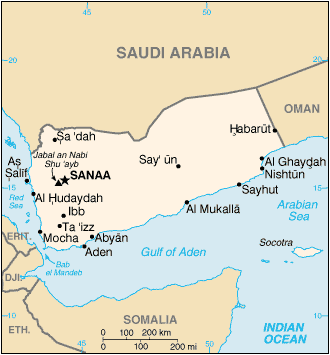The Houthis of Yemen

The history of the rebel group that has overthrown the government
The Houthis, an insurgent group based in northern Yemen, gained political and military strength in the latter part of 2014 and into early 2015. Their meteoric rise from being a regional threat to the country's power brokers threatened to further destabilize the Middle East, especially with Saudi Arabia inserting itself into the civil war. Started as a Group to Promote the Revival of ZaydismThe Houthi rebel group, also called Ansar Allah, which means "Partisans of God," is rooted in a movement called Believing Youth, which was formed in 1992 by members of the Houthi family. Originally a religious group that promoted a revival of Zaydism, Believing Youth operated religious schools and camps in the northern region of Saada. They promoted Zaydism, a branch of Shiite Islam whose adherents believe they are descendants the Prophet Mohammed. The Zaydis ruled North Yemen for centuries until Imam Muhammad al-Badr was deposed during the revolution of 1962. In the years after the revolution, Zaydis felt threatened by Wahhabis, followers of a branch of Sunni Islam that is dominant in neighboring Saudi Arabia. The Houthis are backed by Iran, Saudi Arabia's political rival. Saudi Arabia remains a backer of the Yemeni government. The group was peaceful until the U.S.-led invasion of Iraq in 2003, when some members began protesting against the U.S. and Israel. Hussein Badr al-Din al-Houthi emerged as a charismatic leader of the protests and preacher of anti-U.S. and anti-Israel rhetoric. The protests angered President Ali Abdullah Saleh, an ally of the U.S., and al-Houthi became a thorn in Saleh's side. Fighting between government troops and the group, now known as the Houthis, began in the summer of 2004. The Houthis demanded an end to rampant corruption, equality, improved services and infrastructure, regional autonomy, and democratic reforms. Their demands won the support of many in northern Yemen. Battles between the rebels and the government raged between June and August, and several hundred fighters were killed. Government troops killed al-Houthi in September. His brother, Abdul-Malik al-Houthi, succeeded him as leader. A Series of Cease-fires Fall ApartAfter four years of intermittent fighting, which claimed thousands of lives, the government and the rebels signed a cease-fire in February 2008. The truce fell apart just a month later, as battles broke out again between the parties. Violence continued and the Houthi expanded their control over Saada. In August 2009 the army launched an offensive against the rebels, which prompted fierce retaliation. As many as 50,000 people were displaced in the fighting, in addition to another 150,000 who've been made homeless since 2004. Another cease-fire was signed in February 2010. The government accused the Houthis of violating the terms of the cease-fire in March. Full-fledged fighting broke out between the parties in December. The Houthis emerged as leaders in the protests against President Ali Abdullah Saleh during the Arab Spring demonstrations of 2011, earning themselves a seat at the National Dialogue Conference, which established a framework for the future of the government. Houthis Take Over Capital and Assume Control Over the CountryIn 2014, as Al Qaeda in the Arabian Peninsula (AQAP) intensified its attacks in Yemen and the government of President Abdel Rabbo Mansour Hadi proved to be weak and ineffectual, the Houthis took advantage of the instability and began to expand their areas of control. By September, they had taken control of much of the capital, Sana. The rebels and government troops continued to fight, and the battles intensified in January 2015 following the release of a draft constitution that called for Yemen to become a federation of six regions, which the Houthis fear will dilute their power. The Houthis surrounded the presidential palace complex, with Hadi inside, and took his chief of staff hostage. On Jan. 21, 2015, the Houthis and the government signed a cease-fire, in which the Houthis agreed to withdraw from the presidential palace and the government said it would abandon the regional plan and give the Houthis more say in the naming of government officials. The Houthis, however, reneged on the deal, and Hadi was placed under house arrest. On Jan. 22, Hadi and his cabinet resigned, citing the Houthi's failure to abide by the cease-fire. In a strange twist, the Houthis have become allies with former president of Ali Abdullah Saleh, a figure who was the target of their nascent insurgency in 2004. In early February, the Houthis dissolved Parliament and said the body would be replaced with a national council that would then form a committee to name a new president. Later in the month, they said that Parliament would remain in place but a new "peopleâÂÂs transitional council" would be established and serve as an upper house of Parliament. Following this development, President Hadi escaped from house arrest and traveled to Aden. He met with governors from southern regions, who voiced support for his return to power, and began amassing forces loyal to him. Troops loyal to Hadi and those allied with the Houthis and former president Saleh, Hadi's rival, battled for control of the international airport in the southern port city of Aden in March 2015. After pitched battles, Hadi's forces retook the airport and seized a Special Security Force base, which was controlled by Saleh. Hadi's presidential compound was hit by warplanes believed to be under the command of either Saleh or the Houthis. The Houthis retreated and called for talks and an end to the fighting. However, the Houthis then took control of Taiz, YemenâÂÂs third-largest city. In an attempt to stop the Houthi advance, Saudi Arabia launched an offensive on Houthi targets in Yemen on March 26. More than 100 Saudi jets were involved in the airstrikes that crippled the Houthi's air force. Iran backs the Houthis, and the involvement of Saudi Arabia runs the risk of inflaming tension or creating a broader conflict in the Middle East. |

 Map of Yemen
Map of Yemen





